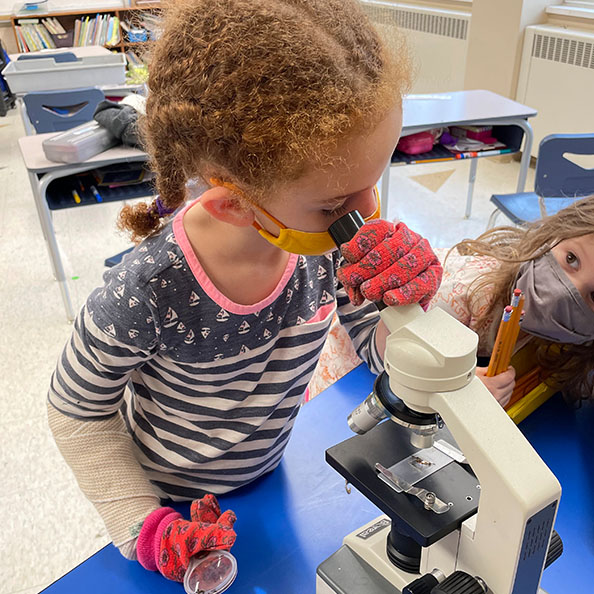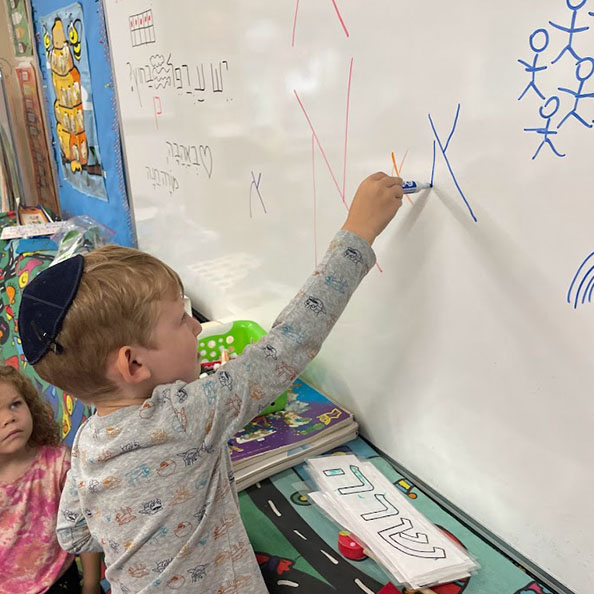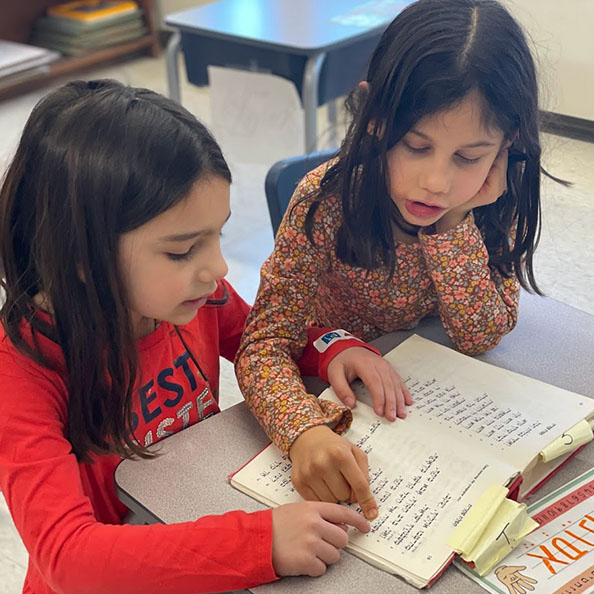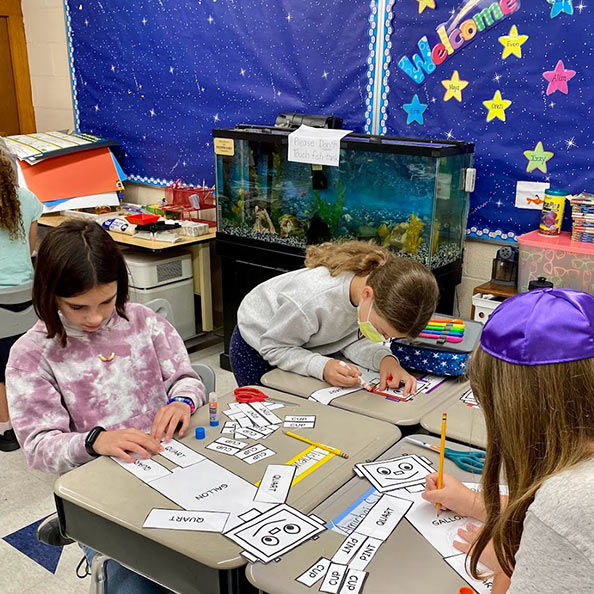Academics
Lower School (K – Grade 5)
Summary
Our Judaic Studies Program focuses on the appreciation of prayer, Torah texts in the original, Jewish values, the development of Jewish identity, and love towards the State of Israel. Children learn to speak, read and write Hebrew and to recite daily prayers. Students learn at an early age that they are part of a diverse Jewish family and community where every voice should be heard and respected.
Our lower school curriculum allows for our collaborative faculty to take advantage of integrating the various disciplines to create a program that allows students to explore and soar. Some of our unique interdisciplinary endeavors include:
- Participating in a Science Fair, which is a place for deep learning that engages our entire community in STEAM projects
- Nurturing Ruth’s Garden, which is our outdoor garden and learning space whose purpose is to create the opportunity for project-based, interdisciplinary learning.
- Engaging in the After-School Art and Band programs, allowing the students to develop their creative skills
- Leading the way in school and community-wide Tikkun Olam (social action) projects to help our wider community.
Parparim (Grades K/1)
GENERAL STUDIES
Language Arts
The Language Arts curriculum is a whole language approach that is used in combination with phonics instruction. Students meet in small guided reading groups that are literature based. Choral reading, readers theater, listening and speaking experiences, journal writing, story dictation, group writing experiences, and exposure to all forms of quality children’s literature build the child’s appreciation for the written word and the ultimate mastery of the skills of reading and writing. All reading activities emphasize reading for meaning and teach strategies to decode unknown words. Children are encouraged to progress at their own pace. As their skills develop, they are exposed to non-fiction, fiction, poetry, and narratives. They also engage in an independent study of spelling words through a variety of creative practice options. Students develop a love of language arts by being able to approach reading and writing in their own unique styles.
Mathematics
The Math curriculum is based on GO Math! which is an approach that emphasizes the existence of mathematics in everyday life. Concepts are developed through whole and small group instruction, manipulation of materials, and daily routines, such as calendar and attendance. Counting games, math board games, geometry, and class preference graphs are some of the ways that our children develop number sense. Younger students focus on recognition of numbers, counting by tens, a basic understanding of place value, and beginning addition and subtraction. Older students focus on more complex addition and subtraction, patterns, coins and currency, telling time, graphing, number lines, numeration and order, and problem solving. Students are encouraged to work at their own pace to support mastery of the skills and concepts.
Science
The Science curriculum is studied in a two-year loop. Our primary area of study is organisms and includes any living structure capable of growth and reproduction. This broad theme enables students to learn about many living things! The first year focuses on the science around us as students explore scientific topics through concrete activities designed to help them become more acutely aware of the natural world. The second year focuses on life cycles and systems including plants, trees, our bodies, and our senses.
Social Studies
The Social Studies curriculum is taught through integration with a variety of other subjects. Students learn about their role and place in the world through the studies of self, family, and the Earth itself. They learn what it means to be a good citizen and how good citizenship is developed. Students study people around the world by learning about their customs and celebrations. They learn about their own background so that they can fully participate in the celebration of all national holidays. As they learn about each other, the cohort grows into a community. School-wide celebrations develop a feeling of community that extends beyond the cohort to include the rest of the school as well. Field trips and parent visits enhance the learning experience.

Hebrew and Judaic STUDIES
Hebrew Language
We utilize the iTalAm Hebrew language program, which is used in many day schools around the world. iTalAm supports the acquisition of language through the use of all five senses, and by creating a visual and auditory Hebrew environment in the classroom that encourages the development of speaking, listening, reading, and writing skills. Students acquire a basic Hebrew vocabulary that includes colors, numbers, days of the week, classroom, and family. They further acquire a repertoire of phrases that they are able to use correctly. Students develop the ability to read Hebrew by mastering the letter and vowel sounds, enabling them to decode unfamiliar words and phrases. They also develop a bank of sight words that they are able to recognize instantly. By the end of the second year in Parparim, students are able to read and comprehend simple picture books in Hebrew. Students also learn to write their names, and to write simple words and phrases in Hebrew.
Torah
Parparim students are introduced to the narrative sections of the five books of the Torah. They are guided to identify the main characters and frequently occurring Hebrew vocabulary in the text. Drama, creative writing, artwork, music, cooking, and supplementary stories enhance the lessons.
Holidays
As each holiday approaches, students are taught to recognize the symbols that pertain to the holiday. They increase their knowledge of each holiday’s customs and rituals and learn to recite the blessings associated with them. Shabbat is joyfully acknowledged each week, with special preparations and prayers.
Prayer
Students become familiar with basic prayers in the morning service, with key words found in those prayers, and with the rituals of Prayer. The Torah is taken out on Mondays and Thursdays, and Havdalah is recited on the first day of the school week. Students also learn the appropriate blessings for food. Students utilize prayer charts during daily tefillot and gradually increase their ability to read some of the prayers in Hebrew. At the end of the year, parents of older Parparim students join together with their children in their morning prayers and then present their children with a beautifully covered and inscribed siddur.

Nesharim (Grades 2/3)
General Studies
Language Arts
The Language Arts curriculum uses a variety of literature and resources to facilitate meeting New York State learning standards. Students are exposed to a variety of literature through individual reading and guided group activities. The use of fiction and non-fiction material integrates curricular activities. Students work to increase fluency and acquire skills to better analyze story structure and characterization, understand inference, and develop the ability to summarize. They learn to identify the main ideas and to find supporting details in what they read. Students are introduced to the writing process and work to utilize spelling patterns and grammar to write stories, book reports, poetry, and research projects. Students are also introduced to cursive writing.
Mathematics
The Math curriculum is based on the GO Math! program, which is aligned to the Common Core. Students work with grade level standards to develop concepts and practice skills through a variety of activities including workbooks, math centers, computer games, and small group activities. The students increase their knowledge of addition and subtraction, and then progress to multiplication and division. They build on their understanding of place value, time, money, geometry, measurement, and problem solving.
Science
The Science curriculum focuses on learning about the Earth’s rocks and minerals, land formations, animal life cycles, simple machines, states of matter, nutrition, and conservation. Children explore using inquiry, literature, hands-on activities, and field trips. STEM activities are utilized to make connections with technology and learning standards.
Social Studies
The Social Studies curriculum focuses on building a better understanding of what makes a community and explores communities around the world. Children learn mapping skills, identify landforms and utilize a globe. Some of our thematic topics include Japan, Brazil and the Rain Forest, Australia, Oceans, and Africa. Students learn about the people, places, cultures, and traditions of each region. Students learn the basics of democracy and government. They also learn about citizenship and the character traits of a good citizen in our school community. Each week, students explore and share current events with their classmates.

Hebrew and Judaic STUDIES
Torah (Chumash)
The Chumash curriculum involves an in-depth study of the first five Torah portions, completed in a two-year cycle. In year one, Nesharim study the Torah portions Bereshit and Noach. In year two, they study Lech Lecha, Vayerah, and Chayei Sarah. The students learn the divisions of the Chumash into five books, fifty-four weekly Torah portions, chapters, and verses. They learn to recite the names of the five books and all fifty-four portions. The students master root words, common verbs, prefixes and suffixes, and develop a vocabulary of frequently occurring words and phrases in Biblical Hebrew that enable them to utilize a Hebrew text. Knowledge of the narrative is stressed, but commentaries (especially Rashi) are introduced as the year progresses. When ready, the students begin to learn Rashi script. Students are encouraged to ask questions about the text and offer their own commentary and interpretations. Emphasis is placed on the conflicts and moral issues experienced by the Biblical personalities and the lessons that can be applied to our own lives. Art, music, movement, and drama enhance our Torah learning.
Parshat HaShavuah
The weekly Torah portion is reviewed each week. Midrash, drama, music, and artistic expression are utilized to enhance the understanding of the text.
Tefillah
Students expand upon the prayers that they have learned in previous years and are exposed to new and more complex prayers from the Shacharit (morning) service. Students explore the background and deeper meanings of the prayers in order to make prayer a personally meaningful experience. Ideas are shared through conversation, music, and creativity. The students pray together in class each day.
Dolphinim (Grades 4/5)
GENERAL STUDIES
Language Arts
The Dolphinim Language Arts curriculum revolves around a whole literacy approach. Students read and write as a whole class, in small groups, and independently. Students integrate what they are reading with what they are writing. Units are based around fiction (focusing on story elements and word choice) and on non-fiction (focusing on author’s purpose, structure, and craft). In writing, students utilize their own interests to complete pieces which follow the steps of the writing process.
Mathematics
The Math curriculum is guided by the New York State learning standards and the GO Math! program. Our main goal is to inspire, educate, and empower children in learning mathematics. Our approach goes beyond teaching algorithms and procedures that make mathematics feel like a lockstep process – with one right way of solving problems. We engage students with open-ended problems, encourage sharing ideas and collaborating with peers, and build number sense by focusing on reasoning and understanding. The emphasis is on understanding the process and developing flexible thinking. Mathematical concepts are grouped by grade level units that are aligned with the Common Core standards. Students learn through a variety of methods, including guided instruction, independent practice, hands-on activities, games, small group work, and projects. Technology is integrated on an ongoing basis. Students practice math facts and skills through online games and activities. Students are encouraged to use Khan Academy and other online tools for individualized practice and reinforcement of skills learned in class.
Science
The Science curriculum is taught in a two-year rotation and covers the following topics: The Solar System; Astronomy; Cells; Human Body Systems; Heredity and Genetics; Energy Transfer through Food Chains and Webs; Photosynthesis; and Weather. Science is taught using a variety of instructional methods, with a focus on inquiry and hands-on experimentation. Students work individually, with partners, or as a group on a variety of experiments and projects. Students learn scientific skills, including how to use the scientific method to solve problems and answer questions. STEM lessons and activities are implemented throughout the two years. The annual school-wide Science Fair gives each student the opportunity to choose a scientific question of personal interest, and then to research, investigate, perform experiments, draw conclusions, and report on findings.
Social Studies
The Social Studies curriculum is completed in a two-year loop. The first year centers on the study of New York State from early inhabitants to immigration. Students complete projects and go on field trips that put them in direct contact with the diverse history of our state. The second year focuses on the history and geography of Latin America and Canada. Students also begin to learn about the United States government and our political system. During both years, students work in groups to study historical writing and artifacts. They also connect what they are learning to current events locally and around the world, and hold weekly classroom debates.

Judaic STUDIES
Torah (Chumash)
The Torah curriculum unfolds in a two-year cycle. In the first year, students study Parashat Toldot through Parashat Vayishlach. In the second year, students study Parashat Vayeshev through Parashat Vay’chi, thereby completing the book of Genesis. The weekly Torah portion is also reviewed. Students learn grammatical constructions unique to the Torah text as well as new vocabulary words that are essential to comprehending the text in Hebrew. Traditional trope (cantillation) is also utilized to support comprehension. Commentaries are introduced to enhance the understanding of the text, and students are encouraged to read closely, think critically, and ask questions.
Prayer
Shacharit and/or mincha prayers are conducted each day in the Beit Midrash. Kabbalat Shabbat is recited on Fridays. In addition, class time is devoted to strengthening prayer skills and developing an understanding of the structure of the siddur and the ideas articulated in the prayers.
Holidays
The Jewish holidays are studied and celebrated as part of both the Hebrew and Judaic Studies curriculum. Students learn the history, vocabulary, traditions, and blessings associated with each holiday, and relate each holiday’s origins and practices to their source in the Tanach.
Mishna
Students engage in a basic exploration of Mishna, examining the more well-known texts as a basis of learning how to extend the traditional text and decipher Rabbinical interpretations. Attention is given to selecting mishnayot that are applicable to the students’ daily lives, creating immediate connection and relevancy and establishing the foundation for future Talmud study.
